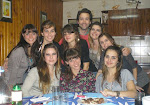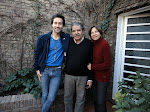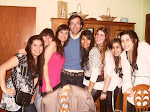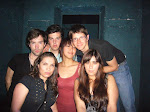First allow me to apologize for my lackadaisical posture toward on-line journaling. To express my deep regret, I would like to borrow from the profound lyrics of one Ms. Britney S. :
"It's been a while. I know I shouldn't have kept you waiting. But I'm here now!"
| At start of life-changing sojourn (Córdoba Airport) |
Shout out: Thank you Emily for your infectious enthusiasm, side-splitting humor, and saintly patience! It was such a treat to have you here!
| Emily, bowling in the desert. |
| A precipitous Andean road |
2) Emily discovered that, when feeling warm inside a moving car, one potential response is to scream in panic about the temperature, although simply taking off your jacket often yields equally pleasant results.
3) We had a crash course in The Art of Bribery 101: South American Roadway Officials and luckily passed the test (after some heavy negotiating). Although corrupt to his core, our young police officer treated us with a surprising level of courteousness while emptying our pockets.
Traversing new parts of Argentina was a great way to give my camera a workout and enjoy breathtaking vistas (imagine the 2002 hit music video of a certain Colombian sweetheart...well, minus herds of wild horses and writhing in the mud). It was also an important personal reminder to keep exploring new places and getting to know different facets of this country. Seeing Argentine communities so different from my own, I was struck by the extent to which our experiences shape our understanding of the world (sounds like a no-brainer but just stick with me).
The northwest, where we spent most of our time is extremely arid and mountainous. The most important cities (Salta, Jujuy, Tucumán) were founded by Jesuits in the 16th century, and many of the people living there are of indigenous (Andean) descent. In contrast, my corner of the country is verdant and flat-as-a-pancake. The towns were settled as agricultural colonies in the 19th century and most people are of Italian descent, with a few Spaniards, Swiss and Germans thrown in for good measure. The point is, these are two utterly different worlds that both call themselves Argentina. Had I not visited the enchanting Andean side of the country, I would have returned to the USA with a skewed and pallid understanding of day-to-day reality for many Argentines!
The following are just a few of the highlights from our trip:
1) The Quilmes Ruins
| The Quilmes Ruins, Tucumán |
The Quilmes were ultimately conquered in 1667, after 130 years of resisting Spanish occupation. As retribution for their continued defiance, the Quilmes suffered the Spaniards' succinctly-named policy of reducción de indios (yes that's really what it was called); a forced relocation march to a settlement on the other side of the country. Sadly, this policy bears a disquieting resemblance to Andrew Jackson's Indian Removal Act of 1830, so if you're familiar with the Cherokees' Trail of Tears, you have a pretty good idea how the rest of the story goes. Nowadays there's a city called Quilmes in Buenos Aires Province, some 1500 kilometers (932 miles) away from the ruins where, on an aside, they produce a wildly popular beer by the same name. What's left in the Calchaquí Valley are the ruins and a coalition of descendants of various indigenous groups, who nowadays are known collectively as the Diaguita.
| Emily hiking above the ruins. |
Recent historical events in a nutshell: the ruins were excavated and restored by an archaeological team in the late 1970's. In the 1990's the provincial government signed a 10-year-lease to a private developer, Héctor Cruz who plunked down a hotel, restaurant and swimming pool on the site. A 2002 government ruling forbade the renewal of the the land lease, and Cruz was forcibly removed in 2007. A Diaguita community organization is now demanding restitution of the ruins, which are currently administered by the Tucumán Tourism Department.
2) Salta, La Linda
| The Church of Saint Francis, Salta |
Typical instrumentation and all-male harmonies
Gaucho style folk dancing
3) Quebrada de Cafayate
| Scenic View in the Quebrada of Cafayate |
A spirit-quest-worthy route if ever one existed, the Quebrada de Cafayate (Cafayate Pass) is a captivating fantasia of geological formations. Thanks to dumb luck, Emily and I got to see the Quebrada frosted in snow for the first time in over a decade. The colorful rock formations are awe-inspiring enough on their own, but the reds, purples, and browns of the valley capped with brilliant white snow is the stuff poets dream of. Route 68, which stretches through 111 miles of craggy wonderland, reels out ribbons, testing the reaction time of hapless motorists, most of whom are thoroughly hexed by the surrounding peaks and buttes. Along the way, curious rock formations with imaginative names such as the toad, the monk and devil's throat serve as pit-stops, providing travelers with terrestrial playgrounds and fine photo-ops.
Just as the laws of gravity start to take effect toward the southern end of the route, travelers enter Cafayate, a charming village and launchpad for visits into the surrounding sea of vines. It seems grapes just love the incongruous micro-climate created by the Cafayate valley's extremely high altitudes and relatively mild temperatures. In fact, at 6,000 feet above sea level, these are some of the highest vineyards in the world. I don't really know what that means in epicurean terms, but Emily and I surely enjoyed the popular Argentine reds (Malbec and Cabernet Sauvignon) produced by Quara Wines, and got to visit several other bodegas or wine cellars where we learned about the fragrant white Torrontés wines this region is famous for.
After several informative and well-packaged tours at large commercial wineries, we hit a steep learning curve in the diminutive backyard/vineyard of Don Antonio Cabezas. Located in the dusty settlement of Tolombón, Don Antonio's is easily missed, marked by little more than a rickety wooden board on the side of the road. In fact, we had to rely on a good-spirited traffic officer to point us in the right direction (Yes, that little house over there. Yes, that one. Yes, he makes wine there).
We whiled away a good part of the afternoon at Don Antonio's, uninterrupted by a single other guest. As the sole proprietor of the business, Señor Cabezas works several acres of land with a crew of about 10 hired hands, and he doesn't really bother with exporting, domestic shipping or any marketing, really. He has been producing wines in Tolombón for his entire life and currently specializes in 2 or 3 different types (including a sweet torrontés) plus a grape liquor, all of which were SCRUMPTIOUS! Yakking away with Don Antonio was a pleasant way to learn about local agriculture, the wine-making process, and small business management in the Cafayate Valley. Gazing into my crystal ball, I can foresee a logical and lucrative business partnership with Tauzel's Farm Fresh Sweet Corn somewhere down the road!
4) Grand Salinas| Garganta del Diablo |
Just as the laws of gravity start to take effect toward the southern end of the route, travelers enter Cafayate, a charming village and launchpad for visits into the surrounding sea of vines. It seems grapes just love the incongruous micro-climate created by the Cafayate valley's extremely high altitudes and relatively mild temperatures. In fact, at 6,000 feet above sea level, these are some of the highest vineyards in the world. I don't really know what that means in epicurean terms, but Emily and I surely enjoyed the popular Argentine reds (Malbec and Cabernet Sauvignon) produced by Quara Wines, and got to visit several other bodegas or wine cellars where we learned about the fragrant white Torrontés wines this region is famous for.
After several informative and well-packaged tours at large commercial wineries, we hit a steep learning curve in the diminutive backyard/vineyard of Don Antonio Cabezas. Located in the dusty settlement of Tolombón, Don Antonio's is easily missed, marked by little more than a rickety wooden board on the side of the road. In fact, we had to rely on a good-spirited traffic officer to point us in the right direction (Yes, that little house over there. Yes, that one. Yes, he makes wine there).
| Brian, Don Antonio, and Emily |
| Salinas Grandes, Jujuy |
Another famous mountain pass is the Quebrada de Humahuaca, which connects the northernmost city of Jujuy with the Bolivian border. It has served as a critical commercial artery since at least the colonial era, when Spanish administrative laws required that the resources from Argentina be hauled northward to Peru, rather than southward to Buenos Aires. Along the route visitors cross the Tropic of Capricorn and pass through a succession of tiny desert villages. In each pueblo, swarms of shutterbugs vie for space inside tiny chapels, admiring the insouciant angels and haunting saints that have adorned the walls since they were dreamed up by local folk artists some 500 years ago. Outside in the plazas, artisans (and capitalists) make a killing with bric-a-brac laden blankets.
| Cerro de Siete Colores |
| On top of the world |
I am so grateful to Emily for visiting me and helping me explore a new part of the planet; I appreciated all of the new experiences we had, as well as the many echoes from our trip to New Mexico last August. I'm gaga to get back to the Andean Northwest someday, so if anybody wants a guided tour of this enchanted region, just let me know!
My next project? Delving into the tropical northeastern reaches of Argentina. I've recently enjoyed reading an enchanting collection of anthropomorphic children's tales written by the famous author Horacio Quiroga. He spent most of his life in the jungles and plantations near the colossal cascades of Iguaza Falls. I'm also itching to see the ruins of the Jesuit settlements in the categorically-named province of Misiones. They have captivated my imagination ever since watching the Oscar-winning 1986 historical drama, The Mission, in high school global studies class. Plus lately I've been having vivid dreams about an affable, lap-swimming yacaré; a species of crocodile that makes its home in the eastern rivers of Argentina - it's a sign!
Thanks for reading and see you soon!
Brian José











